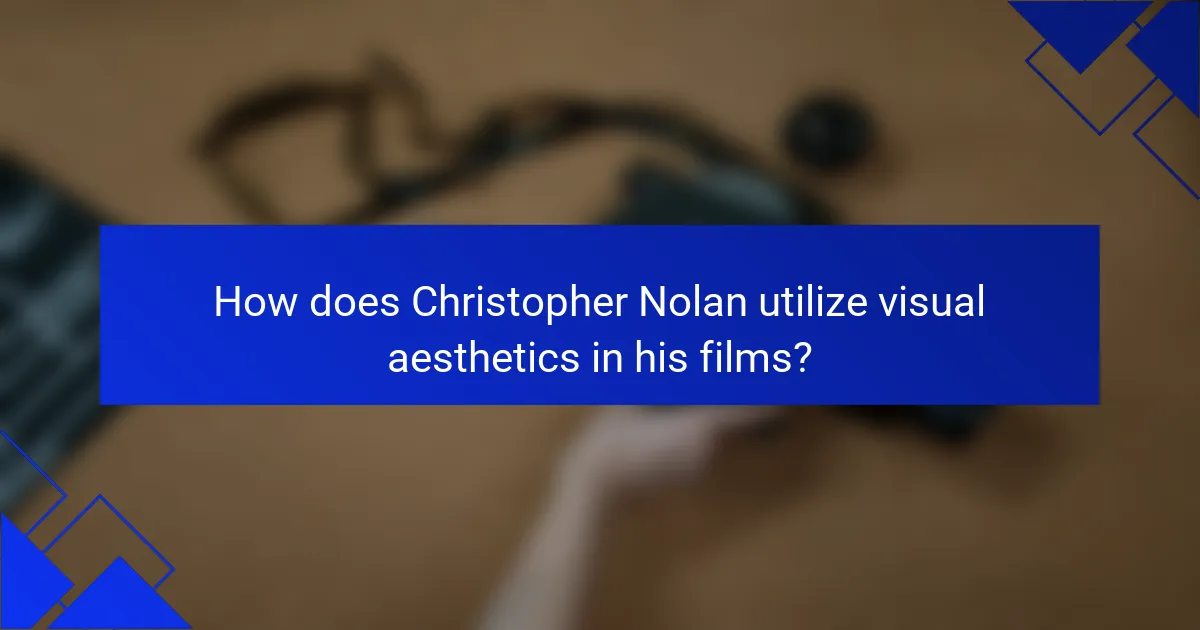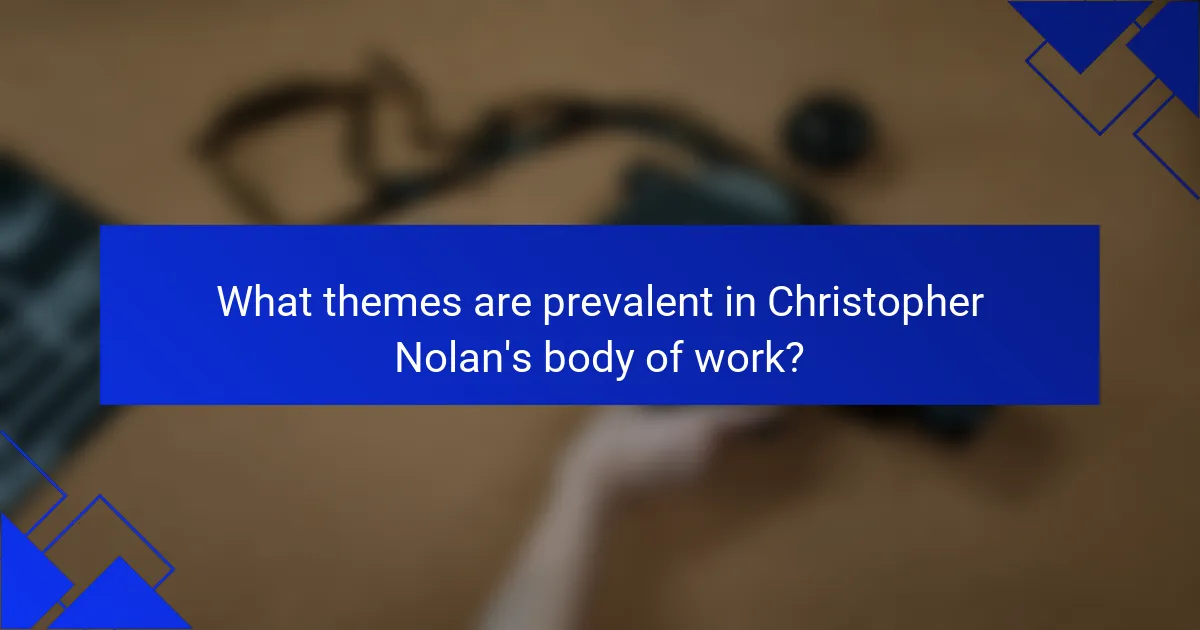
What are the key elements of Christopher Nolan’s storytelling techniques?
Christopher Nolan’s storytelling techniques are characterized by non-linear narratives, complex characters, and thematic depth. His films often employ intricate plots that challenge viewers to piece together timelines. Nolan frequently uses unreliable narrators, which adds layers of intrigue. He explores themes of time, memory, and identity, creating a philosophical underpinning to the narratives. Visual storytelling is also crucial; he utilizes practical effects and IMAX technology for immersive experiences. His collaborations with composers like Hans Zimmer enhance emotional resonance. These elements contribute to a unique cinematic style that engages audiences intellectually and emotionally.
How does Nolan’s use of non-linear narratives impact audience engagement?
Nolan’s use of non-linear narratives significantly enhances audience engagement. This storytelling technique creates a sense of intrigue and mystery. Audiences must actively piece together the timeline and plot connections. This engagement fosters deeper emotional investment in characters and storylines. Research indicates that non-linear narratives can increase cognitive involvement. For instance, studies show that viewers are more likely to discuss and analyze films with complex structures. Nolan’s films, like “Inception” and “Memento,” exemplify this effect. They encourage repeated viewings, enhancing overall engagement and appreciation.
What examples illustrate Nolan’s mastery of non-linear storytelling?
Christopher Nolan’s mastery of non-linear storytelling is exemplified in films like “Memento,” “Inception,” and “Interstellar.” In “Memento,” the narrative unfolds in reverse chronological order, creating a unique experience of memory and perception. This structure immerses viewers in the protagonist’s confusion and disorientation. “Inception” features multiple layers of dreams, each with its own timeline, challenging audiences to piece together the story. The film’s intricate structure enhances themes of reality and illusion. “Interstellar” employs time dilation and non-linear time travel, showcasing how time can be experienced differently. The emotional impact is heightened as characters grapple with love and loss across time. These examples demonstrate Nolan’s ability to manipulate narrative structure, engaging viewers in complex storytelling.
How do these techniques enhance thematic depth in his films?
Christopher Nolan’s techniques enhance thematic depth through non-linear narratives and complex character arcs. Non-linear storytelling allows viewers to piece together the plot, engaging them in a deeper analysis of themes. For instance, in “Memento,” the reverse chronology reflects the protagonist’s disoriented mental state, emphasizing themes of memory and identity. Complex character development, as seen in “Inception,” explores the psychological struggles of each character, adding layers to the narrative. This multifaceted approach invites audiences to reflect on existential questions and moral dilemmas. Nolan’s use of visual symbolism further reinforces these themes, creating a rich, immersive experience that encourages repeated viewings.
What role do character development and dialogue play in Nolan’s films?
Character development and dialogue are crucial in Nolan’s films. They enhance emotional engagement and narrative depth. Nolan creates complex characters that undergo significant transformations. For instance, in “The Dark Knight,” the Joker’s dialogue reveals his chaotic philosophy. This interplay between character and dialogue drives the plot forward. It also establishes moral dilemmas, compelling the audience to reflect. Nolan’s characters often face internal conflicts, making their dialogue pivotal. The depth of these interactions enriches the storytelling experience. Overall, character development and dialogue are integral to Nolan’s cinematic artistry.
How does Nolan create complex characters that resonate with viewers?
Nolan creates complex characters through layered storytelling and psychological depth. He often explores themes of identity, morality, and time. His characters face internal conflicts that drive their decisions. This complexity makes them relatable and engaging. Nolan uses nonlinear narratives to reveal character motivations gradually. He incorporates rich backstories that inform character actions. The dialogue is often introspective, adding to their depth. His films frequently challenge viewers’ perceptions of right and wrong. This multifaceted approach resonates with audiences, fostering emotional connections.
What are some notable examples of impactful dialogue in his work?
Notable examples of impactful dialogue in Christopher Nolan’s work include memorable lines from films like “Inception,” “The Dark Knight,” and “Interstellar.” In “Inception,” the line “You mustn’t be afraid to dream a little bigger, darling” highlights the film’s themes of ambition and imagination. “The Dark Knight” features the iconic phrase “Why so serious?” which encapsulates the Joker’s chaotic philosophy. In “Interstellar,” the dialogue “Love is the one thing that transcends time and space” emphasizes the emotional core of the narrative. Each of these examples showcases Nolan’s ability to blend profound themes with engaging dialogue.

How does Christopher Nolan utilize visual aesthetics in his films?
Christopher Nolan utilizes visual aesthetics through meticulous cinematography and innovative techniques. He often collaborates with cinematographer Hoyte van Hoytema to create stunning visuals. Nolan employs practical effects, such as real explosions and intricate set designs. This approach enhances realism and immerses the audience in the narrative. He also uses non-linear storytelling, which influences visual pacing and composition. The color palette in his films often contrasts dark tones with vibrant highlights, creating emotional depth. Additionally, Nolan’s use of IMAX technology captures breathtaking detail, enhancing the cinematic experience. His films, like “Inception” and “Dunkirk,” showcase these visual strategies effectively.
What are the signature visual styles associated with Nolan’s films?
Christopher Nolan’s films are characterized by a distinct visual style that includes non-linear narratives, intricate framing, and practical effects. His use of IMAX cameras enhances visual depth and detail. Nolan often employs a muted color palette, creating a somber and intense atmosphere. He utilizes deep focus to emphasize both foreground and background elements. The director’s signature use of shadows adds a layer of complexity to scenes. Additionally, he favors wide shots that capture expansive landscapes and intricate set designs. These visual techniques contribute to the immersive experience of his storytelling.
How does cinematography contribute to the overall mood of his films?
Cinematography significantly shapes the overall mood of Christopher Nolan’s films. It employs techniques such as lighting, camera angles, and color palettes to evoke specific emotions. For instance, low-key lighting creates tension and suspense. High-contrast visuals can enhance drama and conflict. Nolan often uses wide-angle shots to convey isolation or grandeur. The choice of color grading affects the emotional tone. Cooler tones may suggest melancholy, while warmer hues can evoke nostalgia. Additionally, camera movement influences pacing and energy. Smooth tracking shots can create a sense of fluidity, while abrupt cuts may induce shock. These elements work cohesively to immerse viewers and deepen their emotional experience.
What techniques does Nolan employ to create immersive visual experiences?
Christopher Nolan employs several techniques to create immersive visual experiences. He utilizes practical effects extensively, which enhance realism. For instance, in “Inception,” he used rotating sets to simulate zero gravity. Nolan also employs non-linear storytelling, engaging viewers in complex narratives. His use of IMAX cameras captures stunning visuals, providing a larger-than-life experience. Additionally, he integrates sound design to complement visual elements, creating a cohesive atmosphere. The combination of these techniques results in a unique cinematic experience that captivates audiences.
How does the use of practical effects versus CGI influence his visual storytelling?
The use of practical effects versus CGI significantly influences Christopher Nolan’s visual storytelling. Practical effects create a tangible, immersive experience for viewers. They often enhance realism and emotional engagement in scenes. Nolan frequently employs practical effects to maintain a sense of authenticity. For instance, in “Inception,” the rotating hallway was achieved through practical stunts. This method allows actors to interact with real environments, enhancing performance. CGI, while useful, can sometimes feel less authentic. Nolan uses it sparingly to complement practical effects. This blend results in a unique visual style that captivates audiences. The choice of effects shapes the narrative’s emotional depth and viewer connection.
What are the advantages of practical effects in Nolan’s films?
Practical effects in Nolan’s films enhance realism and immersion. They create tangible visuals that engage the audience more effectively than CGI. For instance, in “Inception,” the rotating hallway scene utilized practical effects to achieve a visceral experience. This approach allows actors to interact with real environments, improving performance authenticity. Practical effects also contribute to the film’s aesthetic quality, providing a unique texture and depth. Nolan’s commitment to practical effects often results in visually striking sequences that stand out in modern cinema. The use of practical effects can lead to fewer post-production challenges, streamlining the filmmaking process. Overall, practical effects in Nolan’s films foster a stronger emotional connection between the audience and the story.
How does Nolan balance CGI with practical effects to enhance realism?
Nolan balances CGI with practical effects by prioritizing realism in his films. He often uses practical effects for stunts and sets, creating tangible environments. This approach enhances the viewer’s immersion in the story. For instance, in “Inception,” he employed rotating hallways and real explosions. These elements provide a sense of authenticity that CGI alone cannot achieve. Nolan integrates CGI to complement practical effects, not replace them. This method allows for creative visual storytelling while maintaining a grounded aesthetic. His commitment to practical effects has set a standard in modern filmmaking.

What themes are prevalent in Christopher Nolan’s body of work?
Christopher Nolan’s body of work prominently features themes of time, identity, and reality. His films often explore the manipulation of time, as seen in “Inception” and “Interstellar.” Nolan frequently examines the complexities of identity, particularly in “Memento” and “The Prestige.” The nature of reality is another recurring theme, illustrated in “The Matrix” and “Inception.” Additionally, moral ambiguity is prevalent, especially in “The Dark Knight.” Nolan’s narratives often challenge viewers to question their perceptions and beliefs. These themes contribute to his reputation for innovative storytelling and complex visual aesthetics.
How do concepts of time and memory manifest in Nolan’s films?
Christopher Nolan’s films intricately explore concepts of time and memory. He often employs non-linear storytelling to manipulate the viewer’s perception of time. For instance, “Memento” presents a fragmented narrative that reflects the protagonist’s short-term memory loss. In “Inception,” dream layers create varying time dilation, emphasizing how memory is influenced by time. “Interstellar” showcases time’s relativity through gravitational effects, impacting characters’ memories and experiences. Nolan’s use of visual motifs, such as clocks and mirrors, further reinforces these themes. His films often challenge audiences to consider how memories shape identity and reality. This exploration is evident in “Dunkirk,” where multiple timelines converge, illustrating the subjective nature of memory in traumatic experiences.
What films best exemplify the exploration of time as a theme?
Inception, directed by Christopher Nolan, exemplifies the exploration of time as a theme. The film presents a layered narrative structure where time behaves differently in various dream levels. Each level of the dream world has its own time dilation, leading to complex interactions between characters. For instance, a few minutes in the dream can equate to hours in reality. Interstellar, another Nolan film, also explores time through gravitational time dilation. The characters experience significant time differences due to proximity to a black hole. This results in emotional stakes as time passes differently for them compared to their loved ones on Earth. Memento further delves into the theme of time by presenting a non-linear narrative. The protagonist’s short-term memory loss creates a fragmented experience of time. Each scene is revealed in reverse, challenging the audience’s perception of time and memory. These films showcase Nolan’s innovative storytelling techniques that intertwine narrative and temporal exploration.
How does Nolan’s portrayal of memory influence character arcs?
Nolan’s portrayal of memory significantly influences character arcs by shaping their motivations and emotional journeys. In films like “Memento,” characters are defined by their fragmented memories. This fragmentation leads to unreliable narratives that affect their decision-making processes. For instance, Leonard’s quest for revenge is driven by his inability to retain new memories. This creates a sense of urgency in his actions, impacting his relationships with others. Similarly, in “Inception,” Cobb’s memories of Mal drive his guilt and influence his choices throughout the film. This theme of memory as a double-edged sword showcases how it can propel characters forward while simultaneously holding them back. Nolan’s unique storytelling technique emphasizes the complexity of human experience, making memory a central element in character development.
In what ways does Nolan address moral ambiguity and ethical dilemmas?
Nolan addresses moral ambiguity and ethical dilemmas through complex character development and narrative structure. His films often feature protagonists faced with difficult choices. These choices highlight conflicting moral values, creating tension. For example, in “The Dark Knight,” Batman struggles between justice and the greater good. The Joker’s chaotic philosophy challenges Batman’s ethical framework. Similarly, in “Inception,” Cobb’s actions raise questions about reality and personal sacrifice. Nolan uses non-linear storytelling to explore these dilemmas. This structure allows audiences to engage with multiple perspectives. By presenting moral ambiguity, Nolan invites viewers to reflect on their own values. His films provoke discussions about ethics in contemporary society.
How do these themes challenge viewers’ perceptions of right and wrong?
Themes in Christopher Nolan’s films often blur moral lines, challenging viewers’ perceptions of right and wrong. His narratives frequently present complex characters with ambiguous motivations. For instance, in “The Dark Knight,” the Joker’s chaotic philosophy questions the nature of justice. This portrayal forces viewers to reconsider their moral frameworks. Similarly, “Memento” presents a protagonist with a flawed memory, complicating the truth of his actions. Such storytelling techniques create a moral ambiguity that prompts deep reflection. Nolan’s use of non-linear narratives further emphasizes these themes, leading audiences to question their assumptions about morality. Overall, his films invite viewers to engage in a nuanced exploration of ethical dilemmas.
What can aspiring filmmakers learn from Christopher Nolan’s techniques?
Aspiring filmmakers can learn several key techniques from Christopher Nolan’s work. His mastery of nonlinear storytelling captivates audiences and encourages engagement. Nolan often employs intricate plot structures that challenge viewers to piece together narratives. This technique is evident in films like “Memento,” where the story unfolds in reverse order.
Additionally, Nolan’s use of practical effects over CGI enhances realism. For instance, he famously flipped a real truck in “The Dark Knight,” creating a tangible spectacle. His commitment to IMAX technology also showcases how large-format filming can elevate visual storytelling.
Moreover, Nolan’s character development often intertwines with thematic depth. He explores complex moral dilemmas, as seen in “Inception,” prompting viewers to reflect on their values.
Finally, Nolan’s collaboration with composer Hans Zimmer demonstrates the significance of sound design. The score in “Dunkirk” heightens tension and emotion, illustrating how music can amplify narrative impact.
What are best practices for incorporating non-linear storytelling in film?
Best practices for incorporating non-linear storytelling in film include establishing a clear structure. This structure helps audiences follow complex narratives. Use visual cues to guide viewers through time shifts. Flashbacks and flash-forwards can enhance emotional impact. Character perspectives should be distinct to avoid confusion. Each timeline must serve the overall narrative purpose. Employ thematic connections between disparate scenes for coherence. Test screenings can reveal audience comprehension and engagement levels.
How can filmmakers effectively use visual aesthetics to enhance their narratives?
Filmmakers can effectively use visual aesthetics to enhance their narratives by employing color, composition, and lighting. Color can evoke specific emotions and set the tone of a scene. For example, warm colors often convey comfort, while cool colors can suggest tension. Composition directs the viewer’s attention and shapes their interpretation of the story. A well-framed shot can emphasize character relationships or thematic elements. Lighting creates mood and can symbolize character states or plot developments. High contrast lighting can signify conflict, while soft lighting may indicate intimacy. These elements work together to reinforce the narrative and engage the audience. Historical examples include Alfred Hitchcock’s use of color in “Vertigo” to symbolize obsession. Overall, visual aesthetics serve as a powerful tool for storytelling in film.
Christopher Nolan is a renowned filmmaker known for his innovative storytelling techniques and visual aesthetics. This article explores key elements of Nolan’s narrative style, including non-linear storytelling, complex character development, and thematic depth, which engage audiences intellectually and emotionally. It also examines his use of practical effects, IMAX technology, and distinctive visual styles that enhance the cinematic experience. Additionally, the article discusses prevalent themes in Nolan’s work, such as time, identity, and moral ambiguity, highlighting how they challenge viewers’ perceptions and provoke reflection on ethical dilemmas.
